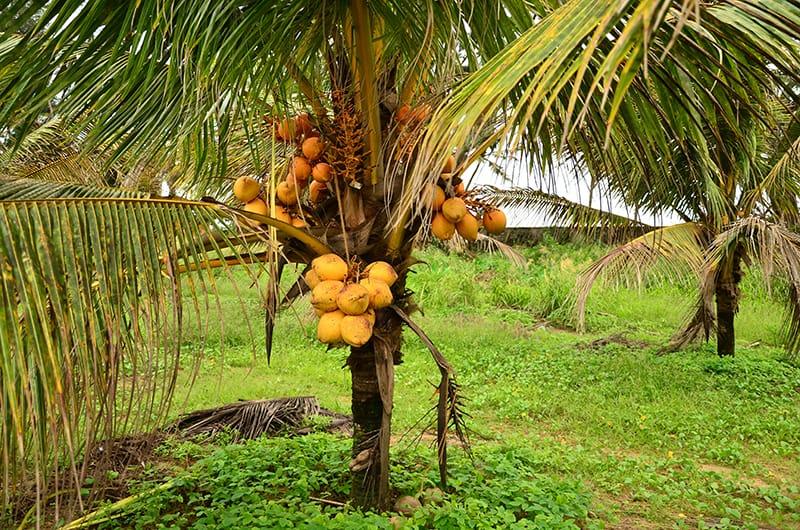
Coconuts are a delicious and versatile fruit and an essential part of many cultures worldwide.
Whether used for coconut water, oil, or cooking, coconuts play a significant role in daily life, especially in tropical regions.
But did you know there are numerous distinct types of coconuts, each with unique characteristics?
In this guide, we’ll introduce you to 15 types of coconuts, ranging from tall varieties to dwarf types. You’ll discover where they grow, how they differ, and their specific uses.
Are you curious to learn more about these fascinating tropical fruits? Let’s dive into the world of coconuts and explore the rich diversity they offer.
Tall Varieties of Coconut

1. West Coast Tall
- Physical Description: Large, oval-shaped coconuts with thick, fibrous husks and medium-to-thick shells. The tree is tall with a wide crown.
- Geographic Origin: Predominantly grown along the west coast of India.
- Growth Characteristics: These trees can grow up to 30 meters tall and are known for their high yield of coconuts, rich in coconut water and oil.
2. East Coast Tall
- Physical Description: These are medium- to large-sized coconuts with a smooth outer surface and slightly thinner shells than West Coast Tall.
- Geographic Origin: Found mainly along the east coast of India.
- Growth Characteristics: East Coast tall trees grow up to 25-30 meters. Coconuts are produced at a slower pace than other varieties but are highly valued for oil production.
3. Panama Tall
- Physical Description: Round to slightly elongated coconuts with a fibrous husk and a hard shell.
- Geographic Origin: Originates from Panama, found across tropical regions of Central and South America.
- Growth Characteristics: This tall coconut tree grows to about 30 meters and is well-suited to tropical climates. It produces coconuts with a high water content.
4. Tiptur Tall
- Physical Description: Medium-sized coconuts with a thin, fibrous husk and a thick, hard shell.
- Geographic Origin: Native to the Tiptur region of Karnataka, India.
- Growth Characteristics: The tree grows up to 20-25 meters tall and is drought-resistant. It produces coconuts known for their quality oil content.
5. Sri Lanka Tall
- Physical Description: Large coconuts with thick husks and a hard shell, oval in shape.
- Geographic Origin: Widely cultivated in Sri Lanka and nearby tropical regions.
- Growth Characteristics: Grows up to 30 meters tall and produces coconuts with a high water and coconut oil yield.
6. Jamaica Tall
- Physical Description: Large, green coconuts with a thick husk, primarily harvested for coconut water.
- Geographic Origin: Native to Jamaica and the Caribbean islands.
- Growth Characteristics: Grows up to 30 meters tall and is known for thriving in warm, humid climates. These coconuts are primarily used for fresh water.
7. Laccadive Ordinary Tall
- Physical Description: Medium-sized coconuts with a thick shell and rich coconut flesh.
- Geographic Origin: Grown in the Lakshadweep Islands of India.
- Growth Characteristics: These trees can grow up to 25 meters and are known for producing coconuts, which are used to make desiccated coconut and oil.
8. Andaman Ordinary Tall
- Physical Description: Large, round coconuts with a thick husk and hard shell.
- Geographic Origin: Grown primarily in the Andaman and Nicobar Islands.
- Growth Characteristics: Grows up to 30 meters tall and is highly adaptable to tropical coastal conditions. The coconuts are often used for oil extraction.
9. Laguna Tall
- Physical Description: Large, oval coconuts with a thick, fibrous husk.
- Geographic Origin: Native to the Philippines, particularly around the Laguna region.
- Growth Characteristics: Grows up to 30 meters tall and is known for producing high-quality coconut oil and water.
10. Renell Island Tall
- Physical Description: Medium to large coconuts with a smooth outer shell and thick husk.
- Geographic Origin: Found primarily on Renell Island in the Solomon Islands.
- Growth Characteristics: Tall trees that thrive in coastal regions and can grow up to 30 meters, producing coconuts with high water content.
11. West African Tall
- Physical Description: Large coconuts with thick husks and hard shells are ideal for oil production.
- Geographic Origin: Grown in the coastal regions of West Africa.
- Growth Characteristics: These trees grow up to 30 meters tall and are well-suited for tropical environments. They produce coconuts, which are used for water, milk, and oil.
12. Vanuatu Tall
- Physical Description: Large, round coconuts with a fibrous husk and thick shell.
- Geographic Origin: Found in the islands of Vanuatu, in the South Pacific.
- Growth Characteristics: The tree grows up to 25-30 meters tall, producing coconuts popular for water and oil production.
13. Kappadam Tall
- Physical Description: Medium to large coconuts with thick husks and high oil content.
- Geographic Origin: Grown primarily in Kerala, India.
- Growth Characteristics: The trees grow up to 25 meters tall and are well-known for their high oil-yielding coconuts.
14. Kerala Tall
- Physical Description: Large, round coconuts with thick husks commonly used for oil extraction.
- Geographic Origin: Native to Kerala, India.
- Growth Characteristics: The tree grows up to 30 meters tall and is popular in Kerala for producing high-quality coconuts for food, oil, and water.
Dwarf Varieties of Coconut

15. Malayan Yellow Dwarf
- Physical Description: Small, yellow coconuts with a thin husk commonly used for coconut water.
- Geographic Origin: Originates from Malaysia, found across tropical regions.
- Growth Characteristics: The tree grows to about 10-12 meters tall and is known for early fruiting and high water content in its coconuts.
16. Malayan Red Dwarf
- Physical Description: Small, reddish coconuts with a smooth shell and thin husk.
- Geographic Origin: Grown in Malaysia and other tropical regions.
- Growth Characteristics: Grows up to 10 meters tall and is known for its ornamental value as well as coconut water.
17. Malayan Green Dwarf
- Physical Description: Small, green coconuts with a soft outer shell and a thin husk, primarily harvested for water.
- Geographic Origin: Native to Malaysia, found throughout tropical regions.
- Growth Characteristics: Grows up to 10 meters tall and is known for its high yield of sweet coconut water.
18. Cameroon Red Dwarf
- Physical Description: Small, reddish coconuts with a smooth outer shell and thin husk.
- Geographic Origin: Commonly grown in Cameroon and other parts of West Africa.
- Growth Characteristics: Grows to about 10-12 meters tall and produces coconuts primarily for water consumption.
19. Chowghat Orange Dwarf
- Physical Description: Small, orange coconuts with a smooth, thin husk and a soft shell.
- Geographic Origin: Found in the Chowghat region of Kerala, India.
- Growth Characteristics: This tree grows up to 8-10 meters tall and is known for its high yield of sweet coconut water.
20. Fiji Dwarf
- Physical Description: Small to medium coconuts with a smooth outer shell and thin husk.
- Geographic Origin: Grown primarily in Fiji and nearby Pacific islands.
- Growth Characteristics: This tree grows to about 10 meters tall and is resistant to diseases. It produces coconuts known for their water and flesh.
21. Macapuno Coconut
- Physical Description: Small to medium coconuts with a soft, jelly-like interior instead of firm flesh.
- Geographic Origin: Native to the Philippines, especially popular in Southeast Asia.
- Growth Characteristics: This dwarf variety grows up to 10 meters and is known for producing coconuts with edible jelly-like flesh, which is often used in desserts.
22. King Coconut (Sri Lanka Dwarf)
- Physical Description: Small, orange coconuts with a thin husk and soft flesh, primarily harvested for its sweet water.
- Geographic Origin: Native to Sri Lanka, commonly grown in South Asia.
- Growth Characteristics: The tree grows to about 10 meters tall and is primarily cultivated for its sweet and refreshing coconut water.
23. Brazilian Green Dwarf
- Physical Description: Coconuts are small, green fruits with a soft outer shell and thin husk. They are mainly used for water.
- Geographic Origin: Found primarily in Brazil and other parts of South America.
- Growth Characteristics: This tree grows to about 8-10 meters tall and is known for high water yield.
24. Pilipog Green Dwarf
- Physical Description: Small, green coconuts with a thin husk and soft shell.
- Geographic Origin: Native to the Philippines.
- Growth Characteristics: Grows up to 10 meters tall and is valued for its high-quality coconut water.
25. Nias Green Dwarf
- Physical Description: Small, light green coconuts with a soft outer shell.
- Geographic Origin: Found primarily in Indonesia, particularly in the Nias Islands.
- Growth Characteristics: Grows to about 8-10 meters and thrives in tropical, coastal areas, producing coconuts known for their refreshing water.
26. Gangabondam Dwarf
- Physical Description: Small, yellowish-green coconuts with a thin shell and soft flesh.
- Geographic Origin: Commonly grown in India.
- Growth Characteristics: This dwarf variety grows up to 10 meters tall and is known for its high yield of coconut water.
Conclusion
Coconuts are a vital part of life in many regions, and understanding the different types helps you appreciate their unique contributions to culture and industry.
From tall varieties like the West Coast Tall to dwarf types like the Malayan Yellow Dwarf, each coconut offers distinct benefits for producing coconut water, oil, or food.
Whether you’re interested in growing coconuts or learning more, this guide provides a great foundation for exploring the coconut’s diversity.
So what’s next? If you found this guide helpful, consider exploring how these varieties are used in industries like skincare and nutrition.

